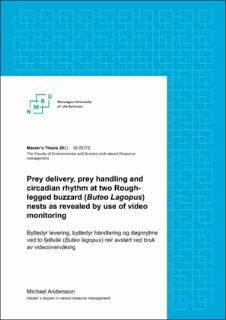| dc.contributor.advisor | Steen, Ronny | |
| dc.contributor.advisor | Sonerud, Geir A. | |
| dc.contributor.author | Andersson, Michael | |
| dc.coverage.spatial | Norway | en_US |
| dc.date.accessioned | 2021-08-26T08:00:37Z | |
| dc.date.available | 2021-08-26T08:00:37Z | |
| dc.date.issued | 2021 | |
| dc.identifier.uri | https://hdl.handle.net/11250/2771324 | |
| dc.description.abstract | Two Rough-legged buzzard (Buteo lagopus) nests, were video monitored during the nestling period in 2017 in Norway. One nest was in Surnadal in Møre and Romsdal county and the other, Goppollvatnet in Innlandet county. This was to gain knowledge on the prey delivered, circadian rhythm at the nests regarding parent delivery and precise time the day and the ability of unassisted feeding as a function of nestling age. Data were collected using video recordings that were activated by sensors when movement was detected at the nest. Videoclips were reviewed on a large screen to identify all deliveries from the surveillance period. The circadian rhythm revealed that prey was delivered during daytime. The diel pattern of delivery differed between the nests, with one distinct delivery peak for Surnadal at 12.30-15.00 hours and two peaks at Goppollvatnet at 08.00-09.00 and 16.00-17.45 hours. At Goppollvatnet 349 prey items were delivered and at Surnadal 159. The most frequent prey delivered at both nests were Microtus voles with 28.3 % at Surnadal and 39.8 % at Goppollvatnet. Lemmings made up 29.8 % of the prey items at Goppollvatnet and none at Surnadal. Birds made up 33.8 % of the delivered estimated prey mass at Surnadal and 4.8 % at Goppollvatnet. The parent delivering pattern as a function of nestling age differed between the two nests. The single nestling in Surnadal started feeding unassisted at a younger age than the two nestlings at Goppollvatnet. This might be due to the female food allocation to increase the survival rate for siblings. Both prey type and nestling age affected the probability of female feeding at Surnadal but only prey type at Goppollvatnet. At Goppollvatnet the probability of feeding unassisted was larger for Microtus voles compared to Norwegian lemmings (Lemmus lemmus) which might explain the difference between the nests in the ability of nestlings feeding unassisted. The probability of swallowing a prey whole was affected by the prey mass at both nests. Whether prey was a shrew, or a vole has affected the probability of swallowing whole at both nests. In the future it might be an idea to set up two cameras from opposite angles to optimize the recordings. This would help getting better images when a nestling might be shielding the prey from one angle. At the same time, the sensibility on the sensors might be adjusted a bit down to avoid unnecessary recordings. | en_US |
| dc.language.iso | eng | en_US |
| dc.publisher | Norwegian University of Life Science, Ås | en_US |
| dc.rights | Attribution-NonCommercial-NoDerivatives 4.0 Internasjonal | * |
| dc.rights.uri | http://creativecommons.org/licenses/by-nc-nd/4.0/deed.no | * |
| dc.title | Prey delivery, prey handling and circadian rhythm at two Rough-legged buzzard (Buteo Lagopus) nests as revealed by use of video monitoring | en_US |
| dc.title.alternative | Byttedyr levering, byttedyr håndtering og døgnrytme ved to fjellvåk (Buteo lagopus) reir avslørt ved bruk av videoovervåking | en_US |
| dc.type | Master thesis | en_US |
| dc.description.localcode | M-NF | en_US |

